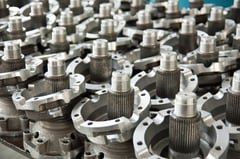
AMRs in the spotlight: Pharmaceuticals
What do Issac Azimov, Hollywood blockbusters, and the wider intralogistics community have in common? They all think that robots are the future. In the specific case of the latter of those three, they believe the robots in question are Autonomous mobile robots. AMRs are an often hyped technology. Videos of fleets of these small wheeled machines moving round warehouses inspire ideas of efficiency, precision, and most of all, futurism.
But are AMRs really the future of the whole economy?
As an independent team of intralogistics experts, the Invar Group works hard to take technology to task. Continuing our series looking into the applicability of AMRs into different sectors of the economy, we’re going to ask – is the future of the pharmaceutical sector powered by AMRs?
Pharmaceuticals – B-Tier
The pharmaceutical sector has a great deal to gain from the AMR revolution. Like many other sectors, the speed, efficiency, and accuracy of AMRs will bring this sector many benefits. Unlike other sectors, there are further benefits that AMRs specifically offer when medicines need moving that could be immensely valuable. However, like some other sectors there are reasons why AMRs by themselves may not be enough to bring about the radical logistical shift that some AMR-providing companies are expecting.
Fully Digital Flowthrough – Much like supermarkets and B2C ecommerce as previously discussed, the complete and utter absence of opportunities for manual error is a major boon for the pharmaceutical sector. This is excellent news both for the B2B intra-industry side of pharmaceuticals, and the B2C consumer connection direct supply. Errors in this area could be a matter of life and death, so the possibility of eliminating them even further is always valuable.
Cleanliness concerns – Efforts to maintain hygiene and cleanliness are important to the supermarket sector also, but in pharmaceuticals the integrity of the process needs a whole new level of focus. The ability of AMRs to contribute high levels of efficiency and accuracy in a clean room environment might well seem to be unparalleled.
However, this is an area where it could be argued either way. Having mobile robots move all around the warehouse introduces the possibility of cross contamination between multiple container units and other such elements interacting with the robots. Something that could be less of a worry with static fixed ASRS (automated storage and retrieval systems). It could be argued that for pharmaceuticals, a more fixed system is more useful because an unmoving apparatus is easier to monitor, clean, and maintain. This element will vary from operation to operation, and is the kind of matter that needs to be assessed individually. For this reason, AMRs start to look less like the “definitive future” of pharmaceuticals, and more like one of a number of possible options.
Traceability – AMRs offer a level of traceability and automated recordkeeping that the pharmaceutical sector especially needs. Being able to know exactly where, and under what conditions every last pill and bottle is being stored is essential to maintaining a safe and effective pharmaceutical product.
Life saving speed – One of the biggest advantages to AMR deployment is speed. AMRs can work consistently and efficiently in a way that manual operators simply can’t. There is no “end-of-shift” slow down. There are no distraction-generating conversations among co-workers. There is no boredom-generated lack of focus that emerges from ongoing performance of repetitive tasks. In a sector like pharmaceuticals, where supply chain inefficiencies can be the difference between life and death, this speed is more essential than arguably any other sector.
B2C Expertise bottlenecks – Unlike supermarkets and B2C ecommerce however, pharmaceuticals do have one rather large potential consideration that may make AMRs less useful than other areas. The bottleneck of experienced staff. You do not need a nutritionist when you go to the supermarket, nor do you need an English literature professor when you visit a bookshop. But when you are buying medicine, medical advice and expertise will need to be part of the equation at some stage. Unlike other sectors, where expertise works at the B2B level only, medical experts will always have to be a part of a substantially large segment of all B2C pharmaceutical transactions.
It is true that B2C pharmaceutical transactions are not all expert-level prescription needs. However, when the B2C over-the-counter transactions are considered, this reduces the overall pharmaceutical market considerably. In light of this, it’s reasonable to infer that the full benefits offered by AMRs will actually only be felt in a specific subset of the pharmaceutical sector. Other areas will gain an advantage, but not in the same complete way that B2C ecommerce might.
Fragility matters – Moving tiny capsules or small to medium sized medicine bottles is something that will, at some point in the process, require more than a modicum of precision and delicate handling. AMRs can certainly be part of the overall logistics process, but much like their application in the supermarket sector, AMRs in pharmaceutical settings will need to be augmented by other technologies. Highly precise pushing, dropping, or reorienting tools such as robotic hands and suction grabbers are just some of the many technologies that could be used in this setting.
Because of this, it may be beholden on pharmaceutical companies to legitimately consider if flexible AMRs might be disadvantageous in the extreme precision moments. The unyieldingly immobile plinths and rails offered by static rail-based ASRS might be a more apt solution in certain circumstances.
Talk to Invar about your options – Maybe you think AMRs are the panacea for your pharmaceutical operation’s logistical woes, or maybe you’re not so sure. If you want a wider perspective on the issue, talk to Invar today.
Written by

Michael Trimmer

Contact Us
Contact us for further independent advice on transforming operational performance in the warehouse.
Contact usRelated Articles

AMRs in the spotlight: Manufacturers (B-Tier)
Is the robotic revolution really right round the corner? Is automation the automatic assumption of...
Read More
AMRs in the spotlight: Small & Medium Enterprises
Are AMRs the best way to meet your future intralogistical needs? That’s the question we at the...
Read More
AMRs in the spotlight: Industrial parts
Autonomous Mobile Robots (AMRs) stand as a beacon of innovation, captivating various sectors with...
Read More